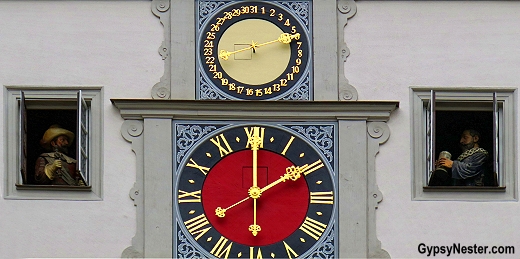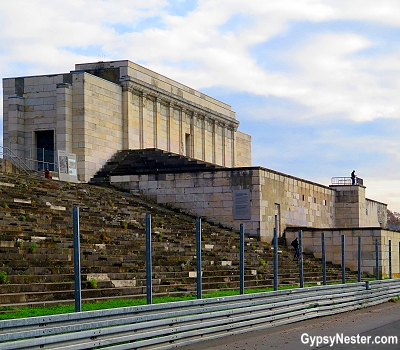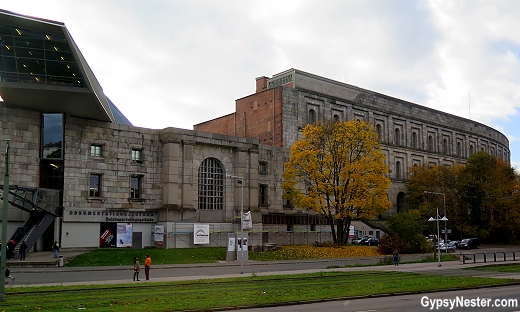Written aboard the Longship Odin on her river voyage with stops in Paris, Luxembourg, Trier, Cochem, Heidelberg, Wurzburg, Rothenburg, Nuremberg, and Prague. Thanks to Viking River Cruises for inviting us along and providing this adventure! As always, all opinions are our own.
Did you miss Dispatch One of this adventure? Click here to catch up!
Day Seven: Heidelberg, an Enormous Amount of Wine, Jail, and a Slight Detour
Morning: Headed to Heidelberg
We awake to a surprise — we’re docked in the heart of one of Germany’s largest and most important cities, Frankfurt. Hmmm, this was not on the itinerary.

Inverted Collar and Tie is a massive sculpture in the
banking district of Frankfurt; a nod to the “suits”<
During the night we had turned off of the Rhine and onto the Main River, but a bridge under construction had collapsed upstream, halting our progress.
Two things happen because of this curveball, first the entire Viking crew has sprung into action to make arrangements that keep all of the plans for our shore excursion to Heidelberg intact, and second, we get to see Frankfurt on the way.
We bus through the financial district of the banking center for not only Germany, but all of Europe.
The city is home to the European Central Bank and the continent’s largest stock exchange, the Frankfurt Stock Exchange.
Quite a contrast to the ancient castles and medieval villages we have been visiting.
Our plans proceed uninterrupted as we begin our day in Heidelberg at the Heidelberger Schloss.
Schloss is another way of saying castle or palace, and a fine way of avoiding our previous redundancy.
We start getting schlossed by crossing over the moat, through the imposing gate, and into the large central courtyard.
Through the years this castle found itself in the middle of much of European history, having been occupied by kings and emperors of Germany, Bavaria, and the Holy Roman Empire.
As with the rest of our journey so far, this is also a renowned wine region, so we have a look down in the castle’s wine cellar.
The world’s largest wine barrel is kept down here, about the size of a small house.
It’s massive, holds 56,000 gallons, and sports a dance floor on top.
Once we descend into the town we find the best vantage point for a view of the entire castle is from the old Heidelberg bridge, Alte Brücke.
In addition to this photo-op, the famous vanity monkey sits at the base of the medieval Bridge Gate, which is part of the former city wall.
This peculiar simian statue of a monkey holding a mirror was erected in 1979, but the tradition of a Heidelberg bridge monkey dates back five or six hundred years. Stories from back then tell of a monkey that served to symbolize the equality between the city dwellers and their country cousins crossing the bridge.
Afternoon: Going to jail and getting a kiss
Heidelberg is also home to the oldest university in Germany. Students from all over the world come to study, as they have been doing since 1386. Up until the time of World War I the university also dealt out its own form of justice.
Since students were not subject to the jurisdiction of the town, the school prosecuted and punished unruly behavior in its own studentenkarzer, or student prison.
As time went by, doing time in the jail became a badge of honor for the students.
They began to decorate their cells with elaborate graffiti, at first using soot from the heaters, and later by smuggling in paint.
By the time the incarcerations ended, in 1914, many of the young scholars were intentionally breaking rules in efforts to get tossed in the pokey.
Many of those little law breakers had no doubt indulged in a Heidelberg Student’s Kiss, so we must too.
The little shop off the main square is still making the delicious confections by the same family recipe that became legendary centuries ago and is run by fifth generation members.
The university in those days was exclusively attended by young men, who’s minds would frequently wander off on to thoughts of young women.
Many of the ladies attending Heidelberg´s finishing schools frequented Café Knösel, which of course attracted the boys, but watchful governesses were never far away.
So Fridolin Knösel, an enterprising chocolatier and master confectioner, invented the Heidelberg Student´s Kiss as a clandestine way for the boys to show their interest in a girl. Simply purchase one of the chocolate covered cookie treats and deliver it to the girl of your choice. Problem solved, and profit made.
Five generations later they are as popular as ever.
See more about ubercharming Heidelberg!
Evening: Where the *@#^% is Mainflingen?

While we enjoyed our stress-free day in Heidelberg, our Viking crew was consumed with constructing contingency plans.
There was no way the ship could make it to our originally planned port due to the collasped bridge, so a hasty alternative had to be found.
This is how we came to discover the tiny town of Mainflingen.
Everyone involved performs above and beyond the call of duty.

From the ship’s crew finding and docking the vessel at this remote pier, to the bus drivers navigating the tiny back roads while frantically searching Google Maps for Mainflingen, to the passengers relentlessly finding the humor in the situation.

When our new friend, Bruce, announces as we pull the bus past a no-vehicles-allowed sign onto a bike path along the river, “Look, the Flingers are coming out to see us!” the entire bus roars with laughter.
The passengers’ jocularity continues over dinner, and we will be, no doubt, spending the night forging full steam ahead.
We shall see what tomorrow will bring, but we’ll bet the Odin‘s crew will make everything work out fine, all the while with a smile on their faces.
Day Eight: An Amazing Walled City, Some Unexpected Opulence and a-Noodlin’
Morning: Germany’s best preserved medieval town
One of the many great things about a Viking cruise is that shore excursions are included, but today we decide to join an optional, extra side trip to the amazing village of Rothenburg ob der Tauber.
Our journey begins along the Romantic Road, taking us through farmland, forest, and orchards before arriving at what is known as Germany’s best preserved medieval town.
The name means Red Fortress above the Tauber, but we’re not talking castles today.
The town is one big fortress, with the city wall intact all the way around it.
Getting up on top of the wall to walk the perimeter of the town is our prime objective.
From high on the ramparts we have an excellent, and ever-changing, view of the entire town while we walk – checking out every angle of the rooftops, church spires, and defensive towers along the way.
We also have miniature views of the valley through the tiny window slits made in the wall for firing down on any advancing enemies.
These are known as arrow loops, or loopholes, and yes, they are where the term for usurping a rule or law originated – as in a way though the wall without actually breaking it.
The main square is dominated by the Rathaus, or town hall, and the tavern where the council did their drinking, the Ratstrinkstube.
The tower on the tavern is semi-famous for its Meistertrunk clock that depicts a popular legend about the town every hour on the hour.
We parked it at an outside table with a couple of Glühwein at about ten till to wait for the show.
The clock recreates a story that goes back to the early 1600s and the Thirty Years’ War, when Count Tilly and his Catholic troops were laying siege to the town.
As a joke, the count promised to spare the town – if one of its councillors could quaff a full three-and-a-quarter liter tankard of wine in one gulp. Mayor Nusch took the challenge and downed the whole thing nonstop, becoming an instant hero.
We’ve got to say that the clock show doesn’t quite live up to the legend. Two windows open, one with the count, the other with the mayor. While the mayor drinks, very slowly we might add, the count turns to look out over the square.
That’s it, show’s over.
Good thing the rest of the town is so crazy cool.
See more about remarkable Rothenburg ob der Tauber!
Afternoon: Unexpected opulence and some bangin’ street food!

We head back to meet the ship in the bigger city of Würzburg, and have some time to explore before boarding.
The main attraction is the Würzburg Residenz, an over-the-top opulent palace commissioned by two prince-bishops, the brothers Johann Philipp Franz and Friedrich Karl von Schönborn who truly knew how to crush any semblance of separation of church and state. These guys were not going to be outdone by any kings or emperors; they went for a cozy three-hundred room, three-wing circus to rival Versailles.

In the square we find a market reminiscent of the Christmas markets we visited cruising the Danube last year with Viking.
Even with the availability of half-meter sausages, we go for a steaming bowl of schtupf-nodlen, a delicious, rib-sticking mixture of noodles, sauerkraut, onions, and pork belly.

We walk back to the bus while schtupf-ing ourselves silly, pausing only to chew and snap a shot or two off the five-hundred-year-old Alte Mainbrücke, Old Main Bridge.

Back on Odin, we are greeted by this guy…

…before we dress up for the Captain’s Dinner.
Day Nine: Morning on Odin, Smoky Beer, and Bamberg
Morning: Rest and Roaming the Ship

We don’t have an excursion until later today, so we’re hanging out enjoying our stateroom.
There’s nothing quite like opening the balcony curtains and turning on the bow cam on the TV set – so relaxing, in fact, that we end up having to go to the roof to stop falling asleep every couple of minutes.

Odin’s kitchen garden
Not that it’s not relaxing here, too – it’s just kind of embarrassing to be snoozing in public areas of the ship!

We discover that the pilothouse lowers to duck under low bridges – and that David needs to duck at times too!
Afternoon: BAM-berg

We enter the city of Bamberg by crossing two bridges.
Uniquely,the Old Town Hall, the Rathaus, sits between the bridges, built in 1386 — right in the middle of the Regnitz River.
An archway through the center of the structure serves as a gate into the town.


On the way up to the Bamberg Cathedral we pass through the Jewish Quarter and our guide shows us a Stumbling Stone.
These markers are to remember victims of concentration camps, but rather than place them in the sad surroundings of those camps, the remembrance is placed outside the homes where they lived before the atrocities occurred.

The Neue Residenz, sports the best backyard in Bamburg.
The magnificent Rosengarten, where the rose blooms have an absolutely amazing view of the city, and of the castle, Bamberg Altenburg.

The cathedral is quite special itself, since it is the final resting place of both an emperor and a pope.
The tomb of Pope Clement II, the only pope to be buried north of the Alps, is hidden away behind the alter; while emperor Henry II lays prominently displayed in the back of the church with his wife Cunigunde beside him.
Evening: The speciality of the house – beer-wise

Below the cathedral, in the old part of Bamberg, we find the historic tavern and brewery Schlenkerla.
Known to exist since at least 1405, this is the home of the original Aecht Schlenkerla Rauchbier. The brew is widely known as Bamberg’s specialty, smoke beer.
Walking in, we find a classic beer hall where everyone grabs a seat at large communal tables underneath a high concentration of antler-based decorations.

After watching a while, David figures out the brew delivery process.
There is a small window in the wall near the front door. He simply pops my head in, order zwie, and plop down at a table full of other Viking adventurers, local Bambergers, and a few international ex-pat wanderers with a couple half-liters that smell like a campfire.

Inside the tiny service porthole, two barrels of brew are being drained at an impressive rate.
According to tradition, the bräu must be drawn from a wooden barrel. No doubt this adds in preserving the intense smoky character.
There was most likely a time when most beer had this bacon-y fresh-from-the-smokehouse aroma, because drying the hops was usually done over an open fire, but these days the fiery flavor is pretty rare.
At least in our experience, which is hardly limited when it comes to sampling varieties of malted beverages around the world, this is the only smoke beer we have run across. Let’s call it unique and bold, but not a new favorite… but just to make sure, we order another.

Back on board, we are treated to fabulous appys before dinner!
Day Ten: Goodbye Odin, Nuremberg and our First Glimpse of Prague
Sadly, today we disembark from the Odin for good, but the news is not all bad, we still have a few more days left on the tour as we make our way to Prague by motorcoach. We will stop along the way in Nürnberg for a look at some twentieth century history, as well as a glance at one of the Holy Roman Empire’s most important cities.
Morning: The dark side of Nuremberg
Most of us know the name Nürnberg, or Nuremberg, because of the trials held after World War II, and we get a look at the courthouse and prison behind it as we drive through the town but, as home to six huge Nazi Party conventions, the city was important to the Nazi propaganda machine well before the war.
The Nürnberg rallies were held at an enormous open stadium known as the Zeppelinfeld.
As we drove in it was obviously big enough to hold several blimps, but the name is actually slightly deceiving, the only zeppelin to ever land here was back in 1909 when Ferdinand Graf von Zeppelin landed one.
This was actually used as a parade ground and demonstration area to show off the troops to the public.
It became best known to those of us outside of Germany when American troops blew up the huge swastika that stood on top of the grandstands after taking the city in 1945.
Right next to the field Hitler had started what was planned to be the biggest indoor hall ever.
Once the war broke out work was halted, and obviously never resumed, but even just over half finished the place is huge.
We can’t help but notice the cosmetic similarity to the Coliseum in Rome, but on closer inspection it is only skin deep.
The structure lacks any of the classic nature of the original, and so comes off as a weak copy. Still it is impressive just for its sheer size, and parts of it have been put to good use as home to an educational museum.
A big part of why Hitler chose Nürnberg was because of his obsession with Roman and more so the Holy Roman Empire. In his vision he was creating something comparable, and Nürnberg was very important in the empire. Charles IV decreed in 1356 that every new Emperor would spend his first day in office in Nürnberg.
Sobering stuff.
Afternoon: The bright side of Nuremberg
Our first stop in the old town commemorates that event as it is reenacted every day at noon on the clock tower of The Frauenkirche, Church of Our Lady, in the main square.
We stake out a spot right in front just before the bells ring, trumpeters raise their horns (even if only slightly, but they might be tired, they are over 500 years old after all), drummers drum, doors open, and seven guys come out to do a little circling around the king.
The Männleinlaufen, which means running men, depict the seven electors who choose the new emperor.
After three laps the doors close and the show’s over. Although it might seem a bit cheesy to our twenty-first century eyes, it does contain a little history lesson.
Plus, we couldn’t help but think just how amazing the performance must have been to folks back in the fifteen hundreds.
Just one of life’s little pleasures — back in the Middle Ages — and we discover another while wandering through the city market.
There among the stands of great looking fruits, vegetables, cheeses, meats, and breads, we see a sign for “3 im Weckla.”
Meanwhile people are getting served three little sausages on a sliced role.
It doesn’t take too much deducing to figure out what David will be biting into real soon.
While he was more than happy to participate in this local tradition of three small sausages on a roll, we felt the need to look into the story a little deeper.
Since the European Union has seen fit to protect the “original Nuremberg bratwurst,” and about a billion brats are produced each year, we figured this just may be a serious subject. They do take sausage seriously, and strict rules must be followed during production.
But as so often seems to be the case, there is a legend about the Nürnberger Rostbratwürst.
Centuries ago, a man named Hans Stromer was sentenced to life in prison. He accepted his fate, asking only that he be allowed one brat a day.
So the local sausage makers began to make sausages small enough to fit through the keyhole of the jail. Hans went on to live long enough to consume 28,000 of the little links.
We guess he died happy.
Evening: A taste of Prague

We make a quick stop at the Czech border to drink a welcome home toast with our new favorite — and unmatched — Program Director, Radim, on his return to his homeland.
We raise a glass of Becherovka, a wildly popular libation flavored with a secret recipe of herbs.
The nectar has a spicy, yet sweet zing that we understand warms the cockles of any Czech heart.
Cheers! Na zdravi!

Our first glimpse of Prague!

Draft beer comes in two sizes. Veronica’s small version is what
our waiter jokingly referred to as “for children”
After checking in, or should we say Czeching in, to our hotel, we hit the streets in search of a light meal.
It doesn’t take us long to find potato pancakes, goulash, and dumplings.
None of these are hard to find in Prague; pretty much every corner café will be serving them, along with the world’s first Pilsner beer, Pilsner Urquell.

And starting out with a little garlic soup makes it light, right?
(click here for everything you need to know about Czech food!)
Day Eleven: Stunning Prague!
Morning: The largest castle in the world and weird babies

Our tour of Prague begins at the castle, a complex of palaces and churches so huge that it holds the title of largest castle in the world.
It is also one of the few fortresses still in use as an official seat of government, just as it has been for Kings of Bohemia, Holy Roman Emperors, and presidents of both Czechoslovakia and the Czech Republic for over a thousand years.

The two huge cathedrals, The Basilica of Saint George and the Basilica of St. Vitus, are also still in use. St. Vitus is the more impressive of the two, with its incredibly ornate Gothic exterior.
One of the highlights for us are the detailed, and finely preserved gargoyles all the way around the cathedral. These water-spouting works of art go way beyond any gargoyles we have ever encountered.

See more photos of Prague Castle

From the castle we make our way down the hill into the city below.
As we near the famous Charles Bridge we encounter some strange, giant babies in Kampa Park.
These are the work of acclaimed Czech artist David Černý, who originally put ten of the odd infants on the Zizkov Television Tower across town. They were so popular that he made three more tower tykes here, so people could have a closer look.

We make our return to the Charles Bridge, just as the legend of rubbing the statue said we would.
The bridge is often referred to as an outdoor gallery, and the description is accurate, but it is also a theater and a concert stage. Street performers, and artists, are a huge part of the charm of this oldest bridge in Prague.
See more about the Charles Bridge
Afternoon: Old Town Square, the Astronomical Clock and being hams


From the bridge it is just a short walk to the Old Town Square, and we enter this bustling center of the city’s activity just in time for the amazing Astronomical Clock to do its hourly thing.
This is the animated clock tower by which all other clocks should be judged. It is the undisputed heavy weight champion.
Watch: The clock comes to life!
See more about the Astronomical Clock!

After the show, we stop by the stands that line the square for a not-so-light lunch of Prague ham and Halušky.
Classic Prague ham is rotisserie cooked over an open fire, and carved right off the bone onto the plate.
Pretty basic stuff, simply served with a couple of slices of bread, and that’s all that is needed for a real treat.
Just in case the ham might not be enough to stuff us like a turkey, we order a nice big bowl of Halušky on the side. Yeah baby, nothing like potato dumplings with onions, sauerkraut, and yet more ham to top things off. Gobble, gobble!
See more about Old Town Square!


Amazingly, we can still walk, just barely, so we waddle over to the nearby Jewish Quarter, known as Josefov.
One of our favorite stories about the Jewish Quarter is the legend of the Golem.
In the tale, a 16th century rabbi known as the Maharal brought to life a golem he had made out of clay to defend the Prague ghetto from anti-Semitic attacks.
The rabbi had the ability to turn off the golem, but somehow things went awry.
Even though the golem was trying to help, he made a mess of things, but the rabbi managed to stop him and kept the body in the attic of the synagogue just in case he should ever be needed again.
Little clay models are available at all of the stands in Josefov, so we get a pocket sized version. Doesn’t seem like he could go on much of a rampage.

See more about Prague’s Jewish Quarter (and the full story of Golem)!
Evening: Prague is magical at night


As we venture out after dark, we find that the street performers are still going strong.
The ongoing show that graces the streets of Prague certainly doesn’t slow down just because the sun goes down.
Earlier in the day we saw full bands set up on corners, and a favorite from our last trip, Vladimir Pinta, singer, sax, and trombone player extraordinaire.
Our night time stroll finds some new blood in the square, a great keyboard player and singer performing under the watchful eye of the Astronomical Clock, and for a nightcap in front of the opera house, an astounding musician using water filled brandy snifters as his instrument. He played with the skill of a concert pianist… perhaps he should be inside the hall.
Watch: The incredibly talented (and hysterically funny) Peter! He even performs a special serenade to Veronica!
On that beautiful note, we end another Viking Cruise. If it is possible, we had an even better time on this one than on last year’s Christmas Market tour along the Danube. No, come to think of it, it is not possible. Let’s just call it a draw, both were absolutely outstanding. We met some great people and the crew on The Odin was exceptional. Even under a few difficult circumstances they made sure that everything ran smoothly, we didn’t miss a thing and had the time of our lives.
A huge thank you to all involved!
Did you miss Dispatch One of this adventure? Click here to catch up!
David & Veronica, GypsyNester.com
Written aboard the Longship Odin on her river voyage with stops in Paris, Luxembourg, Trier, Cochem, Heidelberg, Wurzburg, Rothenburg, Nuremberg, and Prague. Thanks to Viking River Cruises for inviting us along and providing this adventure! As always, all opinions are our own.

































Great stffu, you helped me out so much!
The Prague castle is unique in that is can boast of encompassing several types of architecture, starting with the 9th century Romanesque styled st.Georges Basilica,
The the St. Vitus cathedral is a combination of 13th century Gothic by King Charles IV and 1890s neo-Gothic on the entrance side.
The big rectangular windows of the Vladislav Hall- which served as the throne room, were the first Renaissance architectural element in Prague dating to the early 15th century.
In the 1780 Empress Maria Theresia, decided to give the castle an architecturally unifying face, by remodeling the the outer parts of the main castle in a restrained style of Baroque, called Theresian Baroque.
And finally in the 1920s, when the newly formed Czech republic was taking root, the first Czechoslovak president T.G Masaryk had parts of the castle remodeled in an late Art Nouveau and Art Deco style, and example is the door way to the president office , visible on the 2nd courtyard.
Thanks for the info Rob.